I think I am going to go out on a limb and pronounce the year 2018 as the year of the smartphone flood. In the past (almost) five years in the industry, I have never seen so many phones being launched in one year in India. Every brand has launched a minimum of three devices in this year (with the exception of Chinese brands which went much beyond three), including Apple, Samsung, Huawei, Oppo, Xiaomi and several other brands.
One of these brands was also Realme, a new sub-brand from the house of Oppo, which launched four new smartphones this year. This would include the Realme 1, Realme 2, Realme 2 Pro and a new U-series of phones that was inaugurated as the Realme U1.
On paper, the Realme U1 competes with the Honor 8C and the Xiaomi Redmi Note 6 Pro. They come with similar hardware specifications and are even sold at similar price points. However, it’s the minute differences between these phones that set them apart. And it’s the same differences that make us wonder as to which phone is a better buy. And that’s exactly what I will help you do by the end of this review.
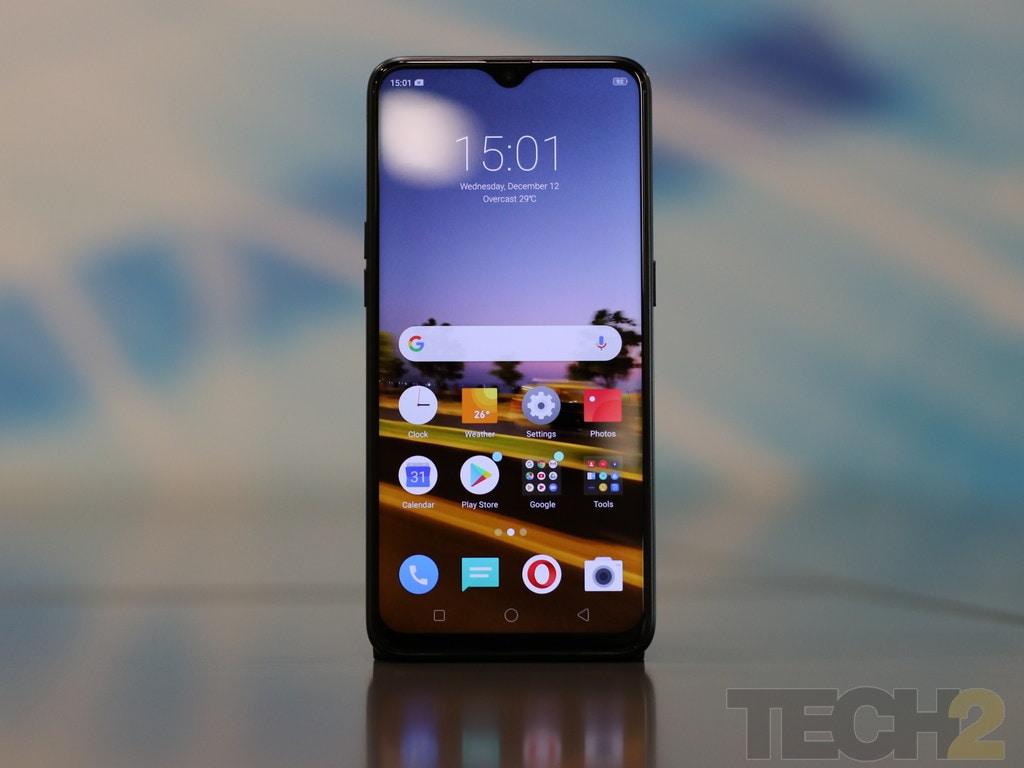
Realme U1 comes in two variants and is priced from Rs 11,999 onwards. Image: tech2/Omkar Patne
Realme U1 Build and Design: 7.5/10
The Realme U1 comes in black and blue colour variants, both of which sport a glass back and a teardrop notch. The device feels very light to hold and is about 8 mm thick. The slippery plastic frame sandwiched between two sheets of 2.5D glass makes it difficult to grip, especially with my tiny hands.
The Realme U1 has a plastic frame around the display that bulges out on all four sides, giving the rather flat device a rounded appearance around the edges. On the left side on the frame, the device features the volume rocker and a SIM tray, and on the right is the power button. The bottom edge, on the other hand, sports a microUSB port, a 3.5 mm audio jack (Yay!) and a set of stereo speakers.
At the back, the phone features a horizontally-placed dual-camera setup, which has an LED flash next to it. Slightly below it sits the fingerprint sensor and towards the bottom is the brand logo ‘realme’.
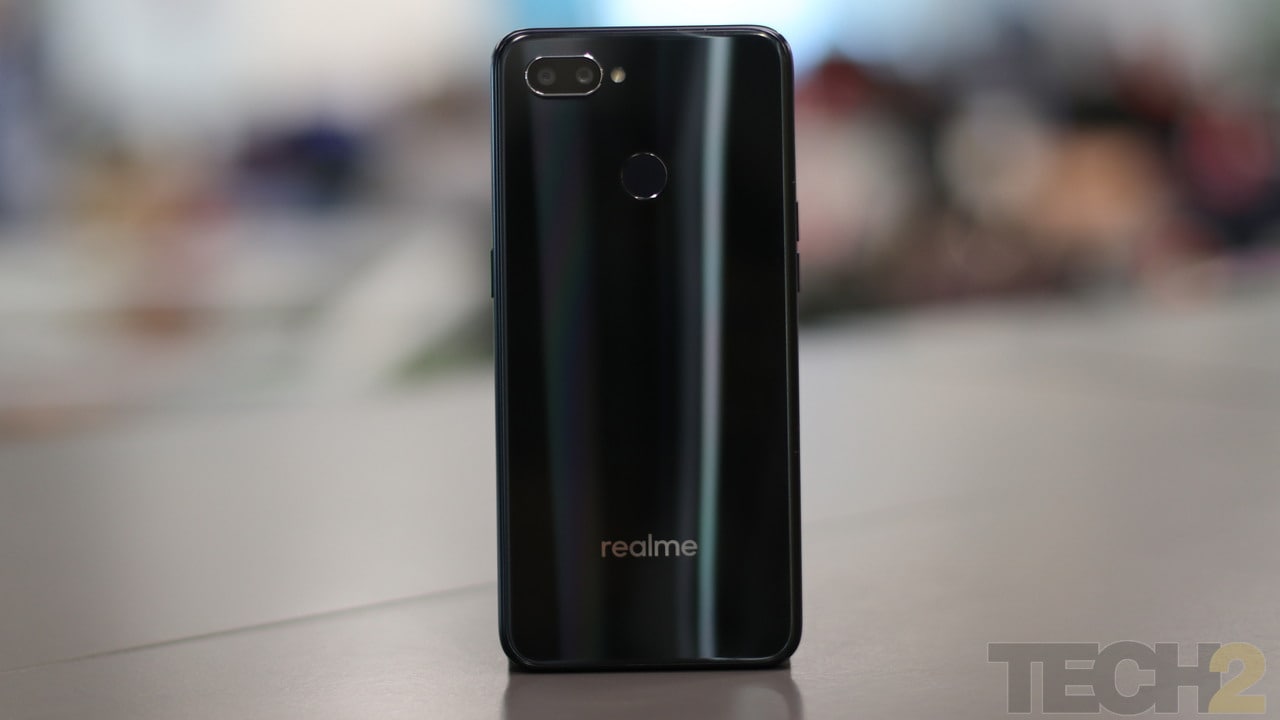
Realme U1 features a glass back that may be a fingerprint magnet, but it really lends a premium feel to the phone. Image: tech2/Omkar Patne
And while we are talking about the rear of the device, I must mention the smudge magnet that it is. While the glass back is a sight to behold on a phone that’s priced at Rs 14,990, be sure that you will be constantly rubbing your phone’s rear against your pants to keep it clean.
What makes the U1’s design better than the Honor 8C and the Note 6 Pro are its thin bezels around that teardrop display, which makes for minimal interference while viewing content. The overall design is the cleanest among the three competing handsets. And no, there is no IP certification on the U1, so be careful around water or liquids.
Realme U1 Features: 7/10
The Realme U1 features a 6.3-inch Full HD+ teardrop display in a 19.5:9 aspect ratio and a 90.8 percent screen-to-body ratio. The display is protected by Corning Gorilla Glass 3.
Under the hood, the device is powered by a MediaTek Helio P70 chipset, which is built on a 12 nm process and features "improved AI performance." Its CPU is an 8-core unit with 4x ARM Cortex A73 cores clocked at 2.1 GHz and 4x Cortex A53 cores clocked at 2 GHz. These are paired with an updated GPU, the ARM Mali-G72 MP3.
For optics, the Realme U1 sports a dual camera setup at the back with a 13 MP primary sensor and a 2 MP secondary sensor. It supports slow-motion video at 90 FPS. Up front is a 25 MP Sony sensor with an f/2.0 aperture. The device’s front camera also comes with a new 'AI Beauty+' mode.
In terms of connectivity, the device features Bluetooth 4.2, Wi-Fi 802.11 b/g/n (2.4 GHz), dual Nano-SIM slots + dedicated microSD card slot. There’s also GPS/A-GPS/GLONASS support, a microUSB port and a 3.5 mm audio jack. The device also has a fingerprint sensor placed on the back and it weighs 168 grams.
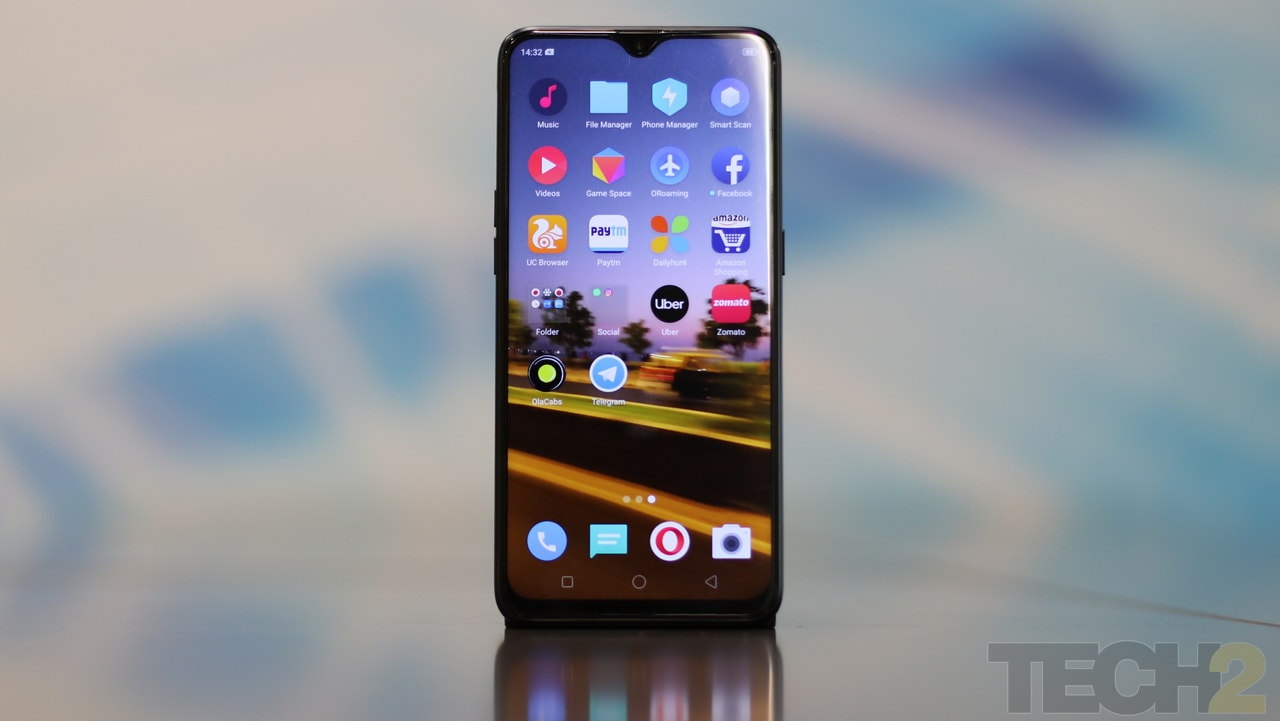
Realme U1 comes with Android 8.1 Oreo OTB with the company's ColorOS 5.2 layered on top. Image: tech2/Omkar Patne
Powering all of the above components is 3,500 mAh battery.
The Realme U1 runs ColorOS 5.2, which based on Android 8.1 Oreo.
Realme U1 Display: 8/10
The Realme U1 has a crisp display with very thin bezels on the sides and top, but a pretty distinct chin. The chin, despite being thicker than the other three sides, is still thinner by a few millimetres when compared to the one on the Honor 8C and Redmi Note 6 Pro. The display produces natural-looking colours and looks really sharp, showing no jagged edges or pixelation despite the fine fonts used in the ColorOS interface.
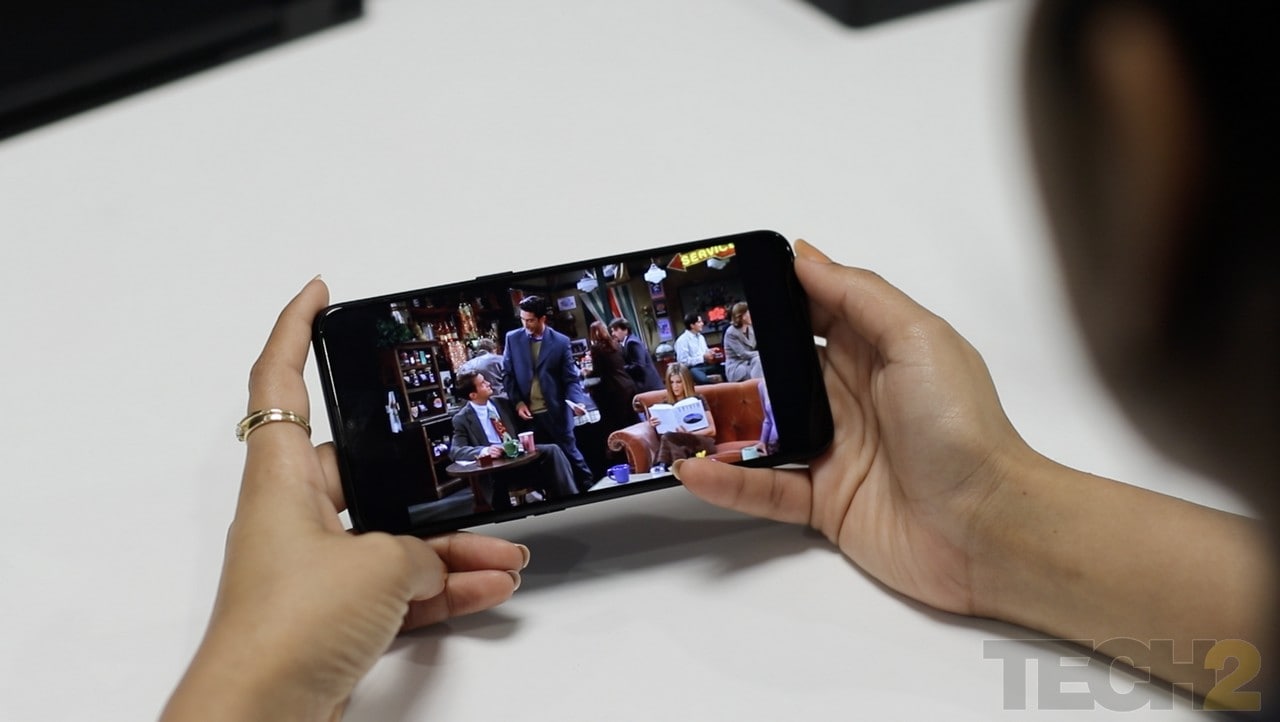
Realme U1 offers great video viewing experience. Image: tech2/Omkar Patne
Under bright lighting conditions, the display adapts to the bright outdoors pretty well, keeping text perfectly legible. Just last month, I also reviewed its competitor, the Honor 8C, and I can say for a fact that the higher PPI on the new Realme U1 definitely looks a lot better.
Thanks to the teardrop notch, the video viewing and gaming experience is a delight on this phone. I watched a bunch of videos and played a few games on the phone and I never found the notch interrupting the view at any time. The Honor 8C, however, wasn’t very well optimised for the display notch.
Realme U1 OS and Software: 7/10
The Realme U1 runs the Android 8.1 Oreo-based ColorOS 5.1. Similar to the Honor 8C, the phone also comes with a DND (do not disturb) mode for gaming, and a multi-screen mode. DND mode basically gives you an uninterrupted experience by screening calls and messages while gaming.
The Realme U1 doesn’t exactly have a bloat-free app drawer. It’s got the full Google apps suite, UC Browser, Amazon’s shopping app, Paytm, Daily Hunt, a music app, videos app, and some other productivity apps.
I must mention here that one of these productivity is a seemingly useful pre-installed cloning app, called Clone Phone. The app is supposed to help you conveniently move data from your old phone to a new one. Normally, this is a very easy process that takes about 30 minutes, depending on the amount of data being transferred from one device to the other.
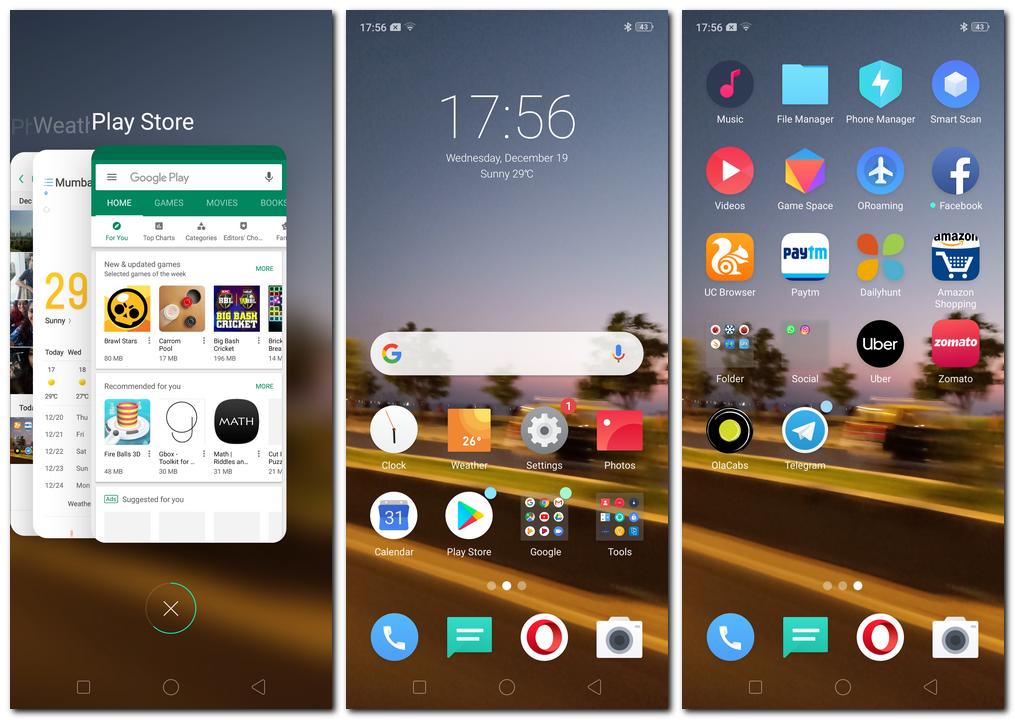
Realme U1 uses ColorOS 5.2 on top of Android 8.1 Oreo out-of-the-box.
However, this turned out to be a problem with the U1. First of all, the Clone Phone app wasn’t available on the Google Play store. I had to look for an APK of the app and after I had downloaded and installed it, Clone Phone would not let me scan the QR code to verify and start the transfer process.
At the end of it, I had to just log in using my Google ID, and then manually download every app I wanted which is a bit inconvenient when you purchase a new smartphone. Basically, I shared this little anecdote with you so you know that transferring from your old phone to the Realme U1 may not be such an easy task, unless your old phone is a Realme or an Oppo device.
Besides this initial hiccup, there wasn’t any issue with the iOS-inspired UI of the device.
Realme U1 Performance 6.5/10
The overall performance of the Realme U1 is very smooth. I remember the lags and hiccups I faced in the UI while reviewing the Honor 8C, however, that wasn’t the issue with this one. Although, the phone heats up slightly while playing games, it did not get hot enough for me to stop what I was doing.
I played a lot of Candy Crush, Word Puzzle, Prince of Persia and Need For Speed: No Limits, on the phone. There was no lag while launching games and no stuttering while playing which made for a good gaming experience considering the MediaTek chipset inside.The DND for Gaming mode can be a delight for hardcore-gamers with no calls or messages bugging you during intense gaming sessions.
The phone was able to churn our decent graphics and textures at medium settings and the battery drain wasn’t particularly much while playing any of the games either.
Further, the Realme U1 features a single speaker at the bottom, and the audio is decently loud and does not crack at high volumes. The cellular calling experience on the device was pretty great too. The speaker, by the way, is placed under the left grille at the bottom edge of the smartphone.
If we look at the benchmark comparison of the three smartphones, Realme U1 does better than both Honor 8C and Xiaomi Redmi Note 6 Pro.
Realme U1 Camera: 7/10
If the camera influences your smartphone buying decisions, then the Realme U1 may be a good bet for you in this price range. The Realme U1 sports a 25 MP front camera that uses the phone’s screen as a flash. Clicking selfies on the phone in daylight results in sharp photos and punchy colours. The selfie cam has three modes, there is an AI mode, a Smart Beauty mode and a Custom Beauty mode. The latter mode lets you save a custom profile of how much "beauty" you want the software to add to your selfies.
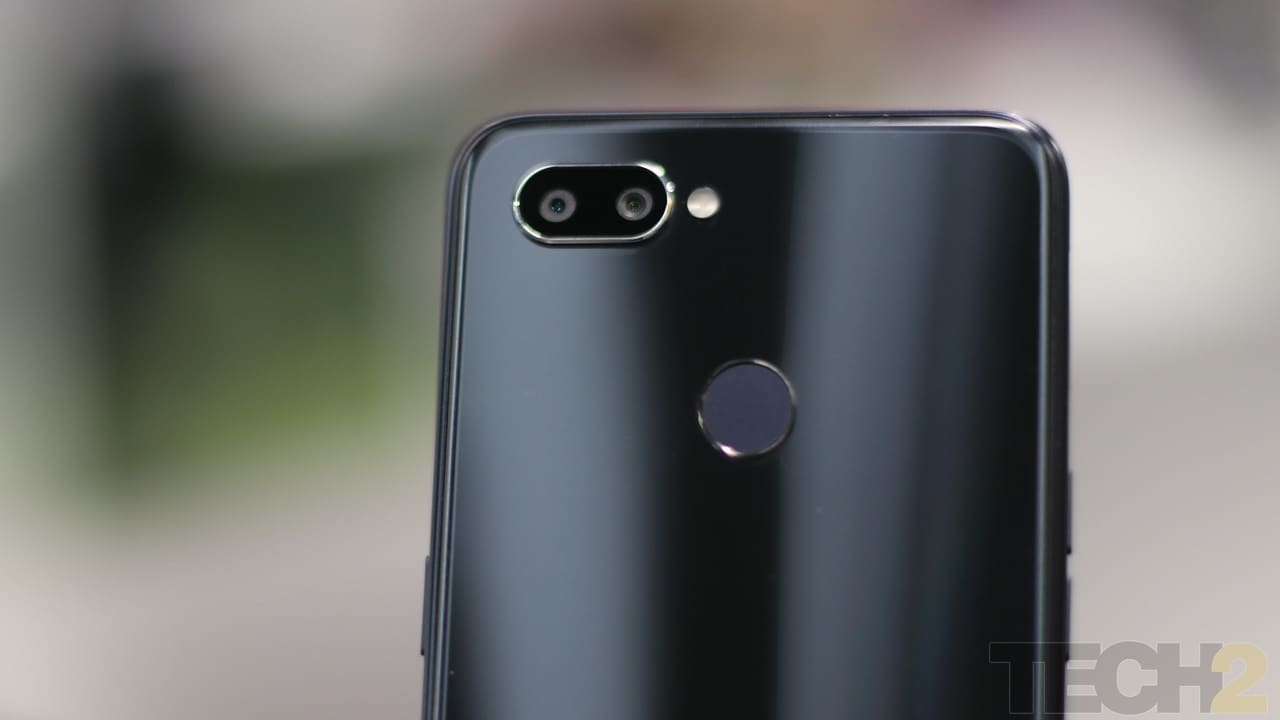
Realme U1 sports a dual-camera setup at the back. Image: tech2/Omkar Patne
The front camera also supports a portrait mode for those who're fans of bokeh-licious selfies (Who isn't?), but it's not that good in practice. If you scroll through the Flickr album below, you will see one of my selfies with the depth effect on, where it's quite apparent that the software blurred some part of my hair as well. The blur also got a bit of the edge of my face, which means that the edge detection does need some work.
The low light selfies are also not very great.
At the back, the Realme U1 features a dual camera setup with a 13 MP and a 2 MP sensor. Images clicked from the rear camera also showcase photos with punchy colours, however, they tend to lose sharpness in some daylight settings at times.
While the camera app can work well most of the time, there are times where it lags a bit. It also doesn’t immediately respond to a tap on the camera button. At times you have to wait for a few seconds after pressing down on the shutter button for the image to get clicked.
In comparison, the Honor 8C has a pretty good camera too, but its images sometimes tend to come out a little over-saturated. The Redmi Note 6 Pro, though, is at par with the Realme U1 in daylight photography, but steals the show when it comes to low light and night time photography.
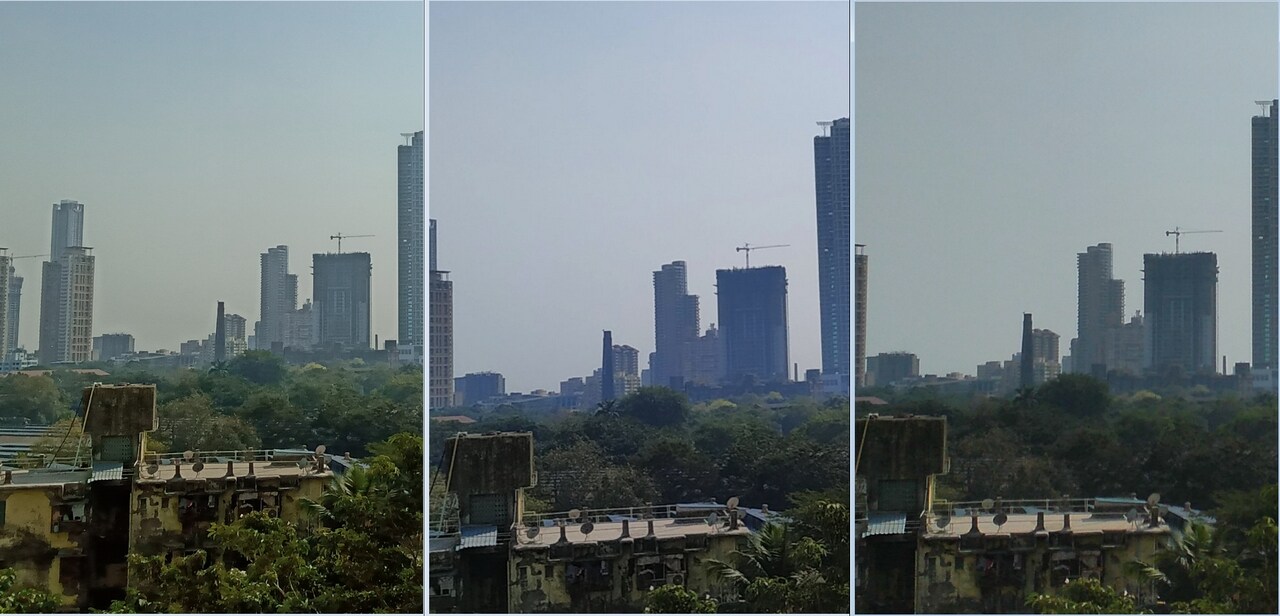
A landscape shot clicked in the day from Realme U1 (L), Redmi Note 6 Pro (M) and the Honor 8C (R).

A portrait shot with the AI mode switched of from Realme U1 (L), Redmi Note 6 Pro (M) and the Honor 8C (R).

A portrait shot using the portrait mode clicked from Realme U1 (L), Redmi Note 6 Pro (M), and the Honor 8C (R).
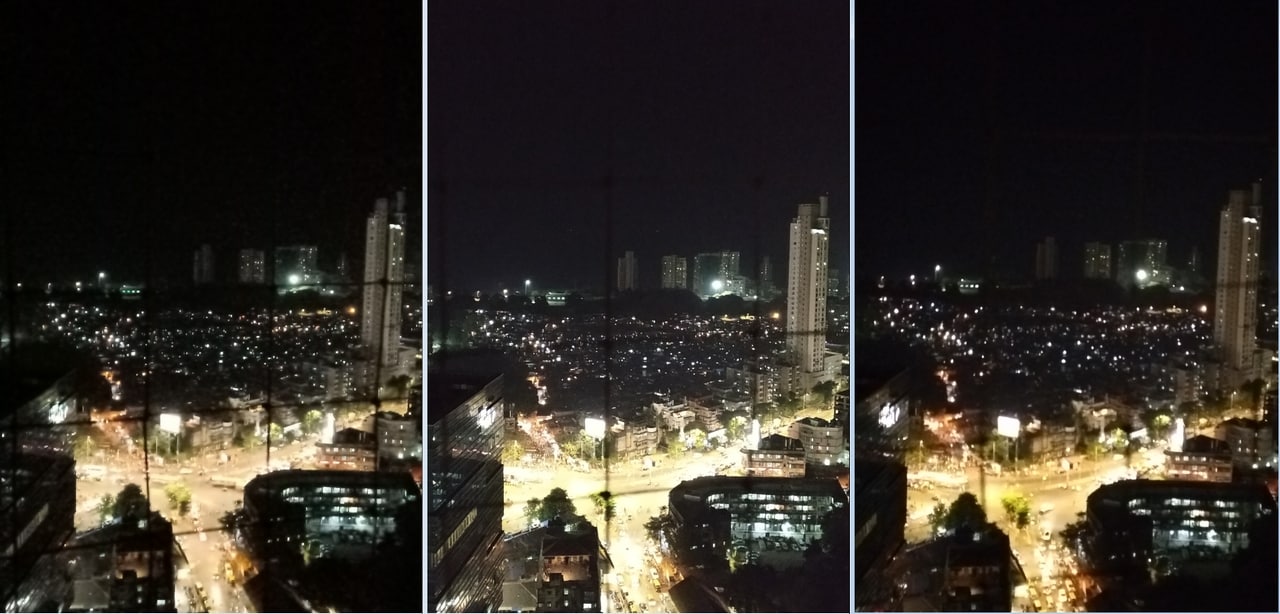
Night shot clicked from Realme U1 (L), Redmi Note 6 Pro (M), and the Honor 8C (R).
Realme U1 Battery Life: 6.5/10
The Realme U1 is fuelled by a 3,500 mAh battery which lasted me well through a day and half. With all the graphic-heavy and internet-consuming apps that I use on a daily basis, I did not feel the need to refuel the device before about 26-30 hours. Sadly, charging speeds are not too fast with the bundled 10 W charger.
The Realme U1’s battery life comes close to Honor 8C’s, but it can’t really catch up to the 2-day battery performance that the latter was able to offer.
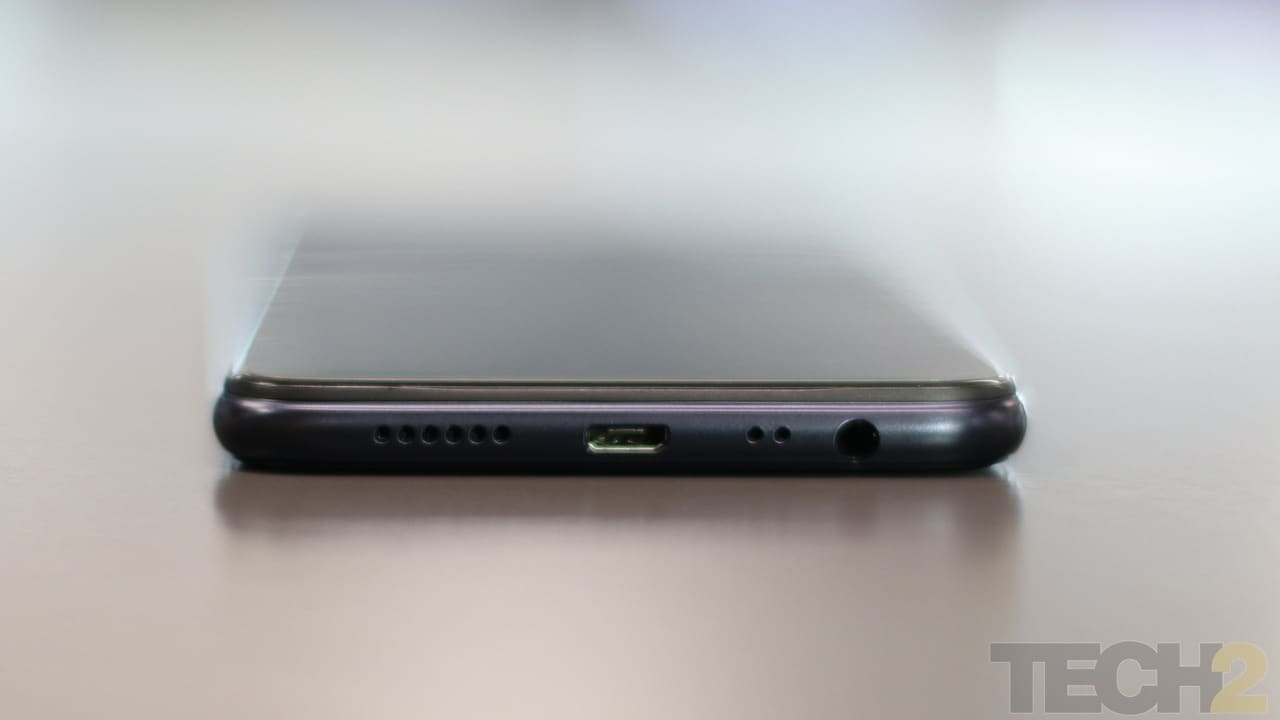
Realme U1 sports a micro USB port for charging. Image: tech2/Omkar Patne
Realme U1 Verdict and Price in India
The Realme U1 is competing in a space where you have rivals such as the Honor 8C and the Xiaomi Redmi Note 6 Pro.
The Realme U1 is great for those looking to buy a well-designed phone which offers good performance, good selfies and is fine with some average battery life. The Xiaomi Redmi Note 6 Pro performs at par with the U1 but takes the cake thanks to its better performance when it comes to clicking good photographs even when the light is low — something where the Realme U1, as well as the Honor 8C, are way behind.
Honor 8C is certainly at the last spot when you look at these three phones unless battery life is what you are after. Realme U1 comes in a comfortable second position. But if your budget is Rs 15,000 or thereabouts, it just makes sense to invest in a Xiaomi Redmi Note 6 Pro. While it may not be a massive jump over the Redmi Note 5 Pro, which had a brilliant all-round performance and value proposition, the Redmi Note 6 Pro edges past its competitors.
The Realme U1 starts at Rs 11,999 for the 3 GB RAM model and the 4 GB RAM variant is priced at Rs 14,999. Considering, that the Realme U1 has a pretty powerful SoC and delivers a decent battery life, the 3 GB variant is actually a smart buy. Unless you are adamant on a higher RAM variant for gaming. But if you want to spend 14k on a new phone, I'd rather you go for the Redmi Note 6 Pro.
TL;DR: Between the Realme U1, Xiaomi Redmi Note 6 Pro and Honor 8C, all these phones have their strengths and weakness, but overall, the Redmi phone offers you a much better deal.
https://dailymotion.com/video/x6z94fm
Tech2 is now on WhatsApp. For all the buzz on the latest tech and science, sign up for our WhatsApp services. Just go to Tech2.com/Whatsapp and hit the Subscribe button.
Source

I have recevid the information news upderting like it
ReplyDelete